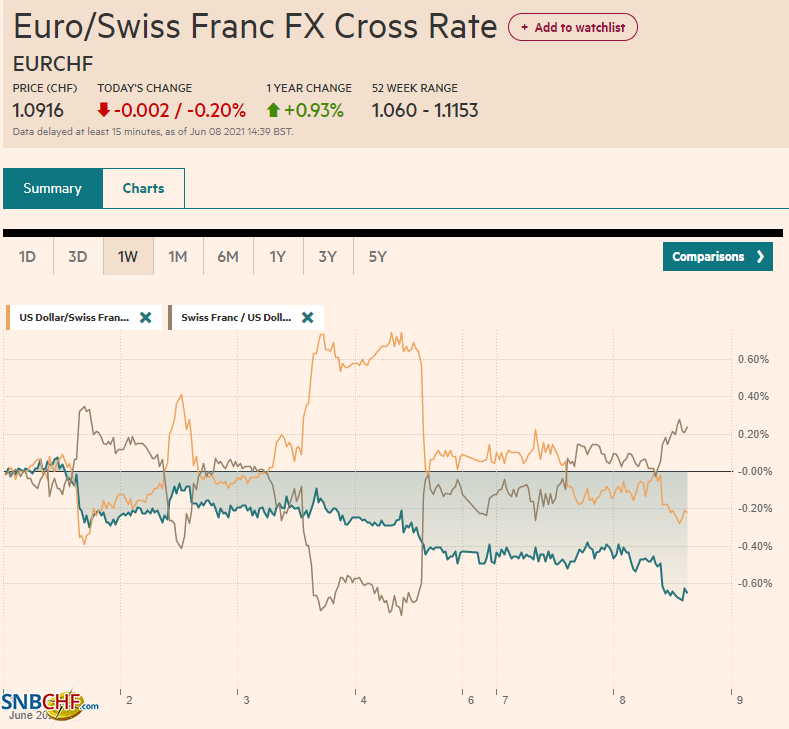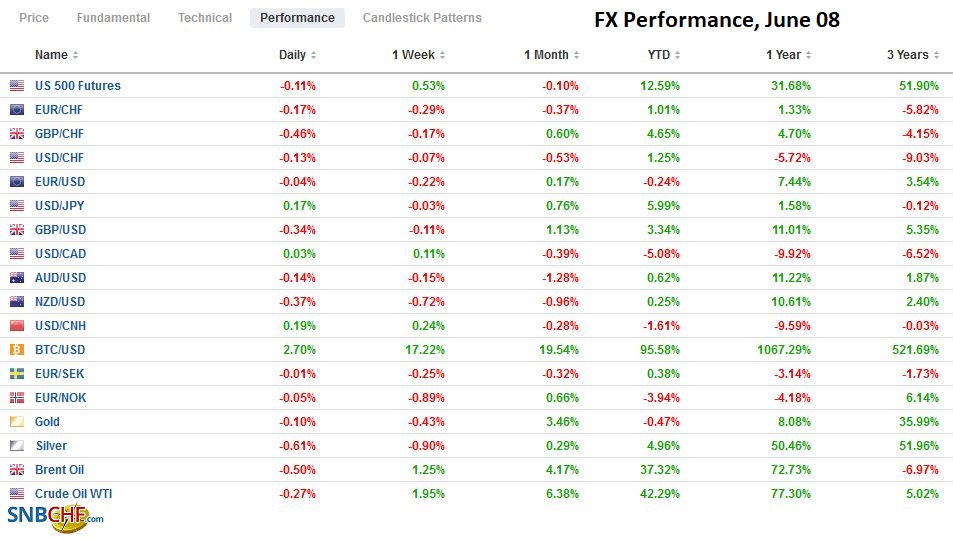Swiss FrancThe Euro has fallen by 0.20% to 1.0916 |
EUR/CHF and USD/CHF, June 08(see more posts on EUR/CHF, USD/CHF, ) Source: markets.ft.com - Click to enlarge |
FX RatesOverview: The capital markets appear to be in a holding pattern ahead of this week’s big events, including the US CPI and the ECB meeting. Equities are little changed but with a heavier bias evident. Most of the large bourses in the Asia Pacific region were lower, except Australia, which eked out a small gain. European markets are little changed, and the Dow Jones Stoxx 600 is straddling unchanged levels. US futures are a little heavier. Benchmark 10-year yields are going no place quickly. The US 10-year is holding just above 1.55%, while European yields are slightly softer. Despite the limited yield support, the dollar is steady to firmer, with sterling, New Zealand dollar, and yen nursing 0.20%-0.35% losses. The Norwegian krone and Swiss franc are posting small gains. Emerging market currencies are little changed, with most of the liquid and accessible currencies posting small declines. Gold was sold after pushing above $1900, and July WTI, which tested $70 yesterday, slipped to around $68.50 today. Those industrial commodities we track, like iron ore, steel rebar, and copper, are down for the second or third consecutive session. The Baltic Dry Index fell for the ninth consecutive session yesterday to bring the decline to more than 25% over the past month. It has returned to mid-April levels, which are still nearly 80% above where it settled at the end of last year. |
FX Performance, June 08 |
Asia Pacific
Japan’s Q1 21 GDP was revised to show a contraction of 3.9% at an annualized rate rather than 5.1%. However, inventory accumulation was revised up to 0.4%, the biggest rise since Q3 17, and the unwinding could weigh on Q2 GDP. Private consumption was revised down to a 1.5% contraction. Yet, looking forward, the unexpectedly strong gain in April cash earnings (1.6% in April, twice the gain the median in Bloomberg’s survey anticipated and the March series revised to 0.6% from 0.2%). The April increase was the most in three years and could fuel a boost in consumption after the emergency is lifted.
Separately, Japan reported its current account surplus has halved in April to JPY1.3 trillion from March. For all but one year (2014) in the past 20, Japan’s current account deteriorates in April. With rising commodity prices, it is understandable why many observers anticipated a negative terms of trade shock for Japan, but it is not materializing. Consider that in Q1 21, Japan recorded an average monthly trade surplus of JPY459 bln. Last year was an anomaly, but in Q1 21, the trade surplus averaged JPY50 bln a month, and in Q1 18, it averaged JPY237 bln a month.
China reported that its foreign exchange reverse repos jumped to $87 bln in April, up from $2 bln in 2020. Some suspect that this could be a sign of officials trying to resist yuan appreciation. It could be, but it seems unlikely. Recall that through Q1 21, the yuan has slipped fractionally against the dollar (~0.4%). April’s rise of 1.2% offset March’s gain. Official efforts to slow the yuan’s appreciation did not appear to begin until May. The dollar trended broadly higher in Q1 as it recovered from the accelerated sell-off in November and December 2020. The yuan appreciated in the last seven months of 2020 and gained another 1.5% in January before falling in February and March.
The dollar recovered from JPY109.20 to almost JPY109.60, around where it peaked yesterday. The option for nearly $1.1 bln at JPY109.50 appears to have already been neutralized. Without better interest rate support, it is difficult to see the greenback rechallenging the JPY110 area.
After peaking above $0.7760, the Australian dollar has drifted lower and, in the European morning, slipped below the $0.7745-$0.7750 area that houses expiring options for almost A$900 mln. Near yesterday’s low is another option that will be cut today (A$400 mln at $0.7725).
So far this month, the yuan is alternating between advances and declines. The yuan ticked up ahead of the weekend, slipped yesterday, and is a touch firmer today. The PBOC’s reference rate for the dollar (CNY6.3909) was close to the median forecast in Bloomberg’s survey (CNY6.3903).
Europe
Following yesterday’s disappointing April factory orders, Germany reported weak industrial output figures today. The 1.0% decline contrasted with the median forecast (Bloomberg survey) for a 0.4% gain, and adding insult to injury, the March series was revised lower (2.2% vs. 2.5%). Separately, the June ZEW survey showed an unexpected pullback in expectations (79.8 vs. 84.4). Recall it finished last year at 55.0. Still, whatever misgivings the expectations component generated were offset by the much stronger than expected assessment of current conditions (-9.1 vs. -40.1). It was the least negative since July 2019.
Italy’s April retail sales fell by 0.4%. The median forecast in Bloomberg’s survey called for a 0.2% gain. Industrial output will be reported ahead of the ECB meeting on Thursday. A 0.3% gain is expected after a 0.1% decline in March. Italy’s economy appears poised to strengthen in the coming months. Meanwhile, surveys suggest that market participants expect the ECB’s bond-buying to stay at an elevated pace in Q3. However, with lower issuance and liquidity in the summer months, the Eurosystem may be challenged. Also, some observers argue that in March, officials talked about a “significantly higher” pace of purchases, and the new language this week could drop the word “significantly”.
The British Retail Consortium reported like-for-like sales in May were 10% above 2019 levels. However, the pace of the economy re-opening may slow. There seems to be an increased push to delay the last stage, which had been penciled in for June 21, for a couple of weeks, as the latest reports on the contagion are somber. The UK economic highlight of the week is Friday’s April GDP figures and the key components (industrial output, construction, services, and trade).
The euro extended its post-US jobs recovery yesterday to trade briefly above $1.2200. An option there for almost 955 mln euros expires today. The euro found initial support near $1.2165 so far today, while yesterday’s low was closer to $1.2145. The consolidative tone looks set to continue.
Sterling is trading within yesterday’s range, which itself was inside the pre-weekend range (~$1.4085-$1.4200). Still, there is scope for sterling to retest yesterday’s low (~$1.4110) within the consolidative phase.
America
The US reports the April trade balance and the JOLTS report on job openings. The preliminary figures suggest April’s trade deficit may have narrowed from the record March level. The JOLTS report is expected to show a high level of job openings. Fed officials are entering their quiet period ahead of next week’s meeting. As the government-sponsored enterprises (GSE) make principal and interest payments and banks begin trimming their balance sheets ahead of quarter-end, there is a lot of cash looking for a home. Yesterday’s reverse repo operation saw a new record to take up of $486 bln from 46 counterparties. The anticipation that the Fed may adjust interest on reserves or reverse repo rate has begun impacting the yield at the bills sales, where crept up at yesterday’s 3- and 6-month auctions. On Thursday, the 4-week and 8-week bills will be sold. Today’s the Treasury will sell $58 bln 3-year notes, and tomorrow will sell $38 bln 10-year notes.
Canada reports April trade figures today ahead of the central bank meeting tomorrow. A decision to take another step toward tapering is bond purchases which is not expected until July. Canada has shed jobs for the past two months and how officials frame it in the context of their April view that the output gap will close in H2 22 is the key to tomorrow’s meeting. Mexico reports monthly CPI figures for May tomorrow. While the rate is expected to moderate, it will remain high (just below 6%), and the market is pricing in nearly 100 bp of hikes over the next year. Meanwhile, Peru’s election remains on a knife’s edge, and investor anxiety over Castillo edging ahead saw local stocks sell off sharply yesterday (~7%) and the sol sell-off by 1.1% after falling almost 3.6% over the two weeks leading up to the election.
The Canadian dollar continues to trade sideways, near its best level in four years. The US dollar is holding above the key CAD1.20 level but has not been able to overcome resistance in the CAD1.2135-CAD1.2145 area since mid-May. Speculators in the futures market have, as of June 1, extended the gross long position for eight consecutive weeks and, with about 89.5k contracts, have amassed the largest position since 2017.
The US dollar traded as high as MXN20.2130 before the US employment report and was sold through MXN19.91 ahead of the weekend. Yesterday’s follow-through dollar selling, encouraged by the fact that the governing coalition may have to temper some of their bolder ambitions, seen as unfriendly to investors, saw the greenback slide to MXN19.7365. It is consolidating around MXN19.80 now. The intraday technicals and soft US rates suggest a test on yesterday’s lows is possible. The four-month low set in May was near MXN19.72.
Graphs and additional information on Swiss Franc by the snbchf team.
Full story here Are you the author? Previous post See more for Next postTags: #USD,China,Currency Movement,EUR/CHF,Featured,Germany,Japan,newsletter,Peru,U.K.,USD/CHF














